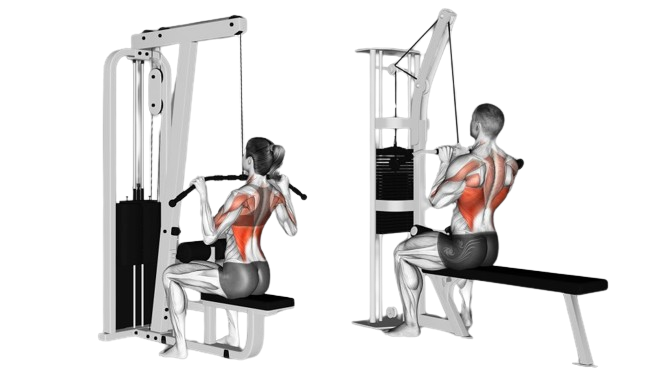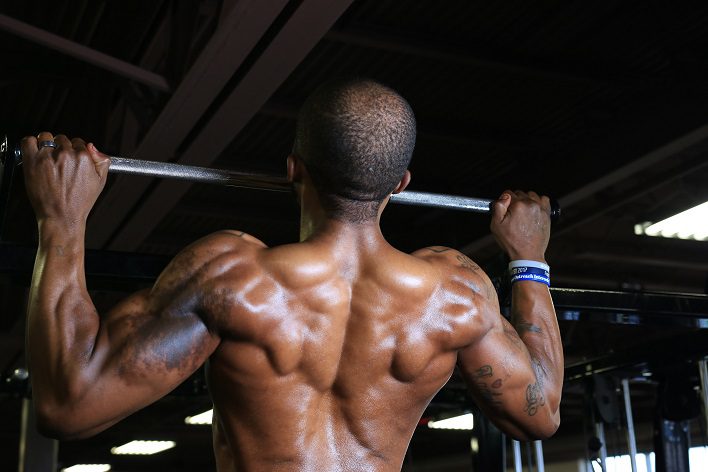Top Lat Pulldown Exercise Alternatives for a Stronger Back

Share This Post
Lat Pulldown Exercise Overview
The lat pulldown is a popular resistance exercise that targets multiple muscle groups in the upper body. It is frequently incorporated into fitness routines for its effectiveness in developing back strength and improving muscular definition.
Muscle Engagement in Lat Pulldowns
The primary muscle worked during the lat pulldown is the latissimus dorsi, which is the broadest muscle of the back and is essential for various arm movements and shoulder stability. Additionally, this exercise engages the biceps, trapezius (traps), and rhomboids, making it a comprehensive upper-body workout. The involvement of these muscles contributes to a stronger back, improved posture, and a more sculpted appearance.
Benefits of Lat Pulldown Exercises
Lat pulldowns offer numerous advantages for individuals looking to enhance their physical fitness. They are a vital exercise for developing solid back muscles, notably the latissimus dorsi, which is crucial for overall pulling strength. Regularly performing this exercise can lead to:
- Strengthened and enlarged latissimus dorsi muscles
- Improved upper body strength
- Enhanced muscle coordination
- Reduced risk of shoulder and back injuries
- Better posture and alignment
- Increased confidence in physical capabilities
It is recommended to perform lat pulldowns within a rep range of 8-15 for muscle hypertrophy or growth, with higher volumes aiding in the development of strength and muscle mass.
For individuals in the UK considering adding this exercise to their regimen, selecting the best attachment for a lat pulldown is key, as different grips can affect muscle engagement. Whether opting for a wide or neutral grip or a close-grip lat pulldown, each variation can target the lats differently and contribute to a well-rounded back training program.

Alternatives to Lat Pulldown
For those who are considering trying the lat pulldown exercise, but don’t have the facility to use a lat pulldown attachment, it’s also useful to explore various exercises that can serve as alternatives. These alternatives not only provide variety to your workout routine but can also be beneficial for those who do not have access to a lat pulldown machine.
Pull-Ups and Variations

Pull-ups are a fundamental exercise for developing upper body strength, particularly in the lats, upper back, and arms. They are an effective substitute for the lat pulldown and can be performed with various grips to target the muscles differently. For instance, an underhand grip (chin-up) will place more emphasis on the biceps, while an overhand grip will focus more on the lats.
The following table provides a comparison of different pull-up variations:
Variation | Primary Muscles Worked | Grip Type |
Standard Pull-Up | Lats, Upper Back, Biceps | Overhand |
Chin-Up | Lats, Biceps, Forearms | Underhand |
Wide-Grip Pull-Up | Lats, Rhomboids, Traps | Wide Overhand |
Close-Grip Pull-Up | Lats, Biceps, Core | Close Overhand |
These variations can be performed with a simple pull-up bar that can be installed in a doorway, making it an accessible option for those seeking to replicate lat pulldown exercises at home. It’s crucial to use proper form to maximise muscle engagement and minimise the risk of injury. For more details on grip techniques, see our articles on wide or neutral grip for lat pulldowns and close-grip lat pulldowns.
Barbell Bent-Over Rows
Barbell bent-over rows are a powerful alternative to lat pulldowns, engaging the lats, traps, rhomboids, and spinal erectors. This movement is integral for developing a stronger and larger upper back.
Exercise | Target Muscles | Equipment Needed |
Barbell Bent-Over Row | Lats, Traps, Rhomboids, Spinal Erectors | Barbell |
The bent-over row allows individuals to handle heavy weights, which is beneficial for increasing both muscle size and strength. To ensure safety and effectiveness, it is imperative to maintain a flat back and use a controlled motion throughout the exercise.
Bench-Supported Dumbbell Rows
Bench-supported dumbbell rows are an excellent way to target each side of the back individually, which can help to correct imbalances and improve muscle isolation.
Exercise | Target Muscles | Equipment Needed |
Bench-Supported Dumbbell Row | Lats, Rhomboids, Traps, Rear Delts, Biceps, Core | Dumbbells, Bench |
This exercise is particularly effective for engaging the lats, rhomboids, traps, rear delts, biceps, and core. By supporting the torso on a bench, it reduces the risk of lower back strain, making it a safer option for those with back concerns.
Incorporating these lat pulldown exercise alternatives into your workout regimen will help you achieve a balanced and strong back. Remember to prioritise proper form to reap the full benefits of each exercise. For those looking to enhance their home workout setup, consider the various attachments available to diversify your training routine.
Additional Lat Exercises
Expanding your back workout routine with additional exercises can enhance strength and muscle development in the latissimus dorsi and surrounding muscles. The following alternatives to the lat pulldown can be integrated into your workout regimen to create a well-rounded program.
Inverted Rows
Inverted rows are a bodyweight exercise that offers an effective way to target the upper back muscles. This exercise is beneficial for individuals who may find pull-ups challenging and can be performed with a barbell in a rack or a Smith machine. The muscles engaged include the lats, traps, rhomboids, erector spinae, biceps, forearms, abs, obliques, hamstrings, and glutes, providing a comprehensive workout.
To perform an inverted row:
- Set the barbell to waist height.
- Lie underneath the bar.
- Grab the bar with a wide or neutral grip, keeping your body in a straight line.
- Pull your chest towards the bar while squeezing your shoulder blades together.
- Lower yourself under control back to the starting position.
Seated Cable Rows

Seated cable rows are a popular alternative to lat pulldowns and are particularly effective in building the muscles of the entire back, with a primary focus on the rhomboids and lats. This exercise is less complex than the bent-over barbell row and is suitable for beginners. You can utilise different lat pulldown grips to vary the emphasis on the muscles worked.
To perform a seated cable row:
- Sit down at the cable row station and place your feet on the footrests.
- Grab the handle using a close grip or another grip variation.
- Keep your back straight and pull the handle towards your abdomen.
- Extend your arms back to the starting position without leaning forwards excessively.
Dumbbell Pullovers
Dumbbell pullovers are a classic exercise that provides an excellent stretch and strengthens the lats under load. This movement is praised for its ability to promote hypertrophic stimulus and is easily accessible, making it an ideal choice for home workouts. It also assists in developing a better mind-muscle connection. To perform a dumbbell pullover:
- Lie on a flat bench with your head near the edge.
- Hold a dumbbell with both hands above your chest, arms extended.
- Lower the dumbbell back and over your head, keeping your arms straight.
- Bring the dumbbell back to the starting position, feeling the stretch in your lats.
Incorporating these exercises into your back workout routine can provide a comprehensive approach to building a stronger back. Whether you’re working out at the gym or at home, these lat pulldown exercise alternatives can help you achieve your fitness goals while keeping your workouts fresh and engaging.

Tips for Effective Back Workouts
Achieving a stronger back requires not only the right exercises but also an understanding of the principles of workout programming, the importance of good form, and the adaptability to perform workouts in different environments, including at home.
Programming Guidelines
When planning your back workout routine, it’s crucial to consider the volume, frequency, and intensity of the exercises. For exercises targeting the latissimus dorsi, such as lat pulldown alternatives, the ideal rep range is typically between 8-15 reps for hypertrophy, with 3-6 sets being optimal for muscle gain and strength development. Rest periods of about 60 seconds between sets can aid in recovery without cooling down the muscles too much.
A balanced workout should include a variety of movements that work the lats through different angles and ranges of motion. Incorporate vertical pulls like pull-ups and horizontal rows for a comprehensive back development. Additionally, isolation exercises such as dumbbell pullovers can be beneficial for focusing solely on the lats and enhancing the mind-muscle connection.
Importance of Proper Form
Maintaining proper form during back exercises is non-negotiable. It ensures the targeted muscles are engaged effectively and reduces the risk of injury. To ensure the lats are the limiting factor in movements like wide or close-grip lat pulldowns, keep the chest lifted and the core engaged. Avoid using momentum to lift the weight; instead, focus on a controlled movement, squeezing the shoulder blades together at the peak of the movement.
Understanding the biomechanics of each exercise can aid in executing them with proper form. For example, dumbbell pullovers allow a full stretch of the lats under load, which can provide an excellent hypertrophic stimulus when performed correctly.
Equipment Adaptations for Home Workouts
Not everyone has access to a fully equipped gym, but that doesn’t mean you can’t perform effective back workouts at home. To replicate lat pulldown exercises, use free weights like dumbbells or barbells for bent-over rows or purchase a lat pulldown attachment for home use. Bodyweight exercises like inverted rows can be performed with sturdy furniture or by installing a simple pull-up bar in a doorway.
For those in the UK looking to enhance their home workouts, investing in versatile equipment such as adjustable dumbbells or resistance bands can also provide a wide range of exercise options. This adaptability ensures that you can continue to challenge your back muscles and progress in your fitness journey, even outside the gym setting.
In summary, for an effective back workout, adhere to programming guidelines that focus on a mix of compound and isolation exercises, prioritise maintaining proper form to engage the right muscles and minimise injury risk, and adapt your equipment needs to suit your workout environment, whether at the gym or home.

More To Explore
The Ultimate Guide to Skipping: Unlocking Strength, Balance, and Stress Relief with a flow rope
Flow rope training is a dynamic workout method that involves using a thick braided rope to create rhythmic, fluid movements. Unlike traditional jump rope exercises, a flow rope workout doesn’t necessarily require jumping. Instead, you move with the rope rather than against it, making it an excellent workout for balance, coordination, and relaxation. Popular among
The Benefits of Training with a Weighted Vest: Boost Your Strength and Endurance
Integrating a weighted vest into workout routines is an increasingly popular fitness strategy aimed at enhancing the effectiveness of various exercises. This comprehensive guide examines how weighted vests can significantly boost physical fitness by increasing the intensity of workouts, details the potential risks, and offers insights into maximising benefits while minimising potential drawbacks. What is